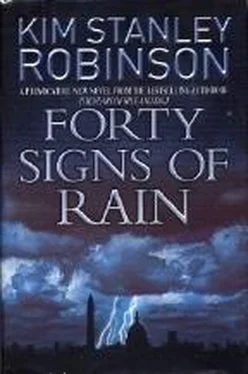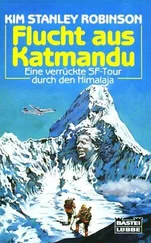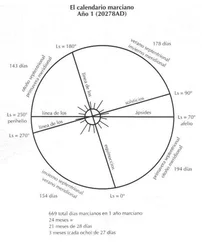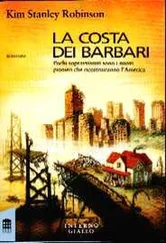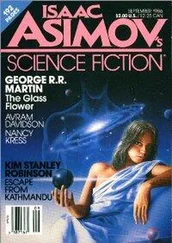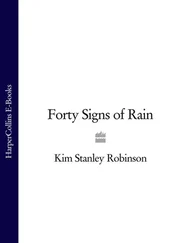These entries were not going to get a lot of responses. But they, like all the rest, were as clear as could be on the fundamental primate needs they were asking for. Frank could have written the urtext underneath them all, and one time he had, and had even sent it in to a paper, as a joke of course, for all those reading these confessions with the same analytical slant he had—it would make them laugh. Although of course if any woman reading it liked the joke well enough to call, well, that would have been a sign.
Male Homo sapiens desires company of female Homo sapiens for mutual talk and grooming behaviors, possibly mating and reproduction. Must be happy, run fast.
But no one had replied.
He went out onto the bas-relief balcony, into the sultry late afternoon. Another two months and he would be going home, back to resume his real life. He was looking forward to it. He wanted to float in the Pacific. He wanted to walk around beautiful UCSD in its cool warmth, eat lunch with old colleagues among the eucalyptus trees.
Thinking about that reminded him of the grant application from Yann Pierzinski. He went inside to his laptop and Googled him to try to learn more about what he had been up to. Then he reopened his application, and found the section on the part of the algorithm to be developed. Primitive recursion at the boundary limit…it was interesting.
After some more thought, he called up Derek Gaspar at Torrey Pines Generique.
“What’s up?” Derek said after the preliminaries.
“Well, I just got a grant proposal from one of your people, and I’m wondering if you can tell me anything about it.”
“From one of mine, what do you mean?”
“A Yann Pierzinski, do you know him?”
“No, never heard of him. He works here you say?”
“He was there on a temporary contract, working with Simpson. He’s a post-doc from Caltech.”
“Ah yeah, here we go. Mathematician, got a paper in Biomathematics on algorithms.”
“Yeah that comes up first on my Google too.”
“Well sure. I can’t be expected to know everyone who ever worked with us here, that’s hundreds of people, you know that.”
“Sure sure.”
“So what’s his proposal about? Are you going to give him a grant?”
“Not up to me, you know that. We’ll see what the panel says. But meanwhile, maybe you should check it out.”
“Oh you like it then.”
“I think it may be interesting, it’s hard to tell at this stage. Just don’t drop him.”
“Well, our records show him as already gone back up to Pasadena, to finish his work up there I presume. Like you said, his gig here was temporary.”
“Ah ha. Man, your research groups have been gutted.”
“Not gutted, Frank, we’re down to the bare bones in some areas, but we’ve kept what we need to. There have been some hard choices to make. Kenton wanted his note repaid, and the timing couldn’t have been worse. Coming after that stage two in India it’s been tough, really tough. That’s one of the reasons I’ll be happy when you’re back out here.”
“I don’t work for Torrey Pines anymore.”
“No I know, but maybe you could rejoin us when you move back here.”
“Maybe. If you get new financing.”
“I’m trying, believe me. That’s why I’d like to have you back on board.”
“We’ll see. Let’s talk about it when I’m out there. Meanwhile, don’t cut any more of your other research efforts. They might be what draws the new financing.”
“I hope so. I’m doing what I can, believe me. We’re trying to hold on til something comes through.”
“Yeah. Hang in there then. I’ll be out looking for a place to live in a couple of weeks, I’ll come see you then.”
“Good, make an appointment with Susan.”
Frank clicked off his phone, sat back in his chair thinking it over. Derek was like a lot of first-generation CEOs of biotech start-ups. He had come out of the biology department at UCSD, and his business acumen had been gained on the job. Some people managed to do this successfully, others didn’t, but all tended to fall behind on the actual science being done, and had to take on faith what was really possible in the labs. Certainly Derek could use some help in guiding policy at Torrey Pines Generique.
Frank went back to studying the grant proposal. There were elements of the algorithm missing, as was typical. That was what the grant was for, to pay for the work that would finish the project. And some people made a habit of describing crucial aspects of their work in general terms when at the prepub stage, a matter of being cautious. So he could not be sure about it, but he could see the potential for a very powerful method there. Earlier in the day he had thought he saw a way to plug one of the gaps that Pierzinski had left, and if that worked as he thought it might…
“Hmmmm,” he said to the empty room.
If the situation was still fluid when he went out to San Diego, he could perhaps set things up quite nicely. There were some potential problems, of course. NSF’s guidelines stated explicitly that although any copyrights, patents, or project income belonged to the grant holder, NSF always kept a public-right use for all grant-subsidized work. That would keep any big gains from being made by an individual or company on a project like this, if it was awarded a grant. Purely private control could only be maintained if there had not been any public money granted.
Also, the P.I. on the proposal was Pierzinski’s advisor at Caltech, battening off the work of his students in the usual way. Of course it was an exchange—the advisor gave the student credibility, a sort of license to apply for a grant, by contributing his name and prestige to the project. The student provided the work, sometimes all of it, sometimes just a portion of it. In this case, it looked to Frank like all of it.
Anyway, the grant proposal came from Caltech. Caltech and the P.I. would hold the rights to anything the project made, along with NSF itself, even if Pierzinski moved afterward. So, if for instance an effort was going to be made to bring Pierzinski to Torrey Pines Generique, it would be best if this particular proposal were to fail. And if the algorithm worked and became patentable, then again, keeping control of what it made would only be possible if the proposal were to fail.
That line of thought made him feel jumpy. In fact he was on his feet, pacing out to the minibalcony and back in again. Then he remembered he had been planning to go out to Great Falls anyway. He quickly finished his cottage cheese, pulled his climbing kit out of the closet, changed clothes, and went back down to his car.
The Great Falls of the Potomac was a complicated thing, a long tumble of whitewater falling down past a few islands. The complexity of the falls was its main visual appeal, as it was no very great thing in terms of total height, or even volume of water. Its roar was the biggest thing about it.
The spray it threw up seemed to consolidate and knock down the humidity, so that paradoxically it was less humid here than elsewhere, although wet and mossy underfoot. Frank walked downstream along the edge of the gorge. Below the falls the river re-collected itself and ran through a defile called Mather Gorge, a ravine with a south wall so steep that climbers were drawn to it. One section called Carter Rock was Frank’s favorite. It was a simple matter to tie a rope to a top belay, usually a stout tree trunk near the cliff’s edge, and then rappel down the rope to the bottom and either free-climb up, or clip onto the rope with an ascender and go through the hassles of self-belay.
One could climb in teams too, of course, and many did, but there were about as many singletons like Frank here as there were duets. Some even free-soloed the wall, dispensing with all protection. Frank liked to play it just a little safer than that, but he had climbed here so many times now that sometimes he rappelled down and free-climbed next to his rope, pretending to himself that he could grab it if he fell. The few routes available were all chalked and greasy from repeated use. He decided this time to clip onto the rope with the ascender.
Читать дальше
Конец ознакомительного отрывка
Купить книгу
